Aérospatiale Alouette II
| SA 313/SA 318 Alouette II | |
|---|---|
.jpg) | |
| A West German Alouette II helicopter patrolling the border with East Germany, 1985 | |
| Role | Light helicopter |
| National origin | France |
| Manufacturer | Sud Aviation Aérospatiale |
| First flight | 12 March 1955 |
| Introduction | 2 May 1957 |
| Status | In service |
| Primary users | Tunisian Air Force Royal Cambodian Air Force Pakistan Army Swiss Air Force |
| Produced | 1956-1975 |
| Number built | 1,300+ |
| Variants | Aérospatiale SA 315B Lama |
| Developed into | Aérospatiale Alouette III |
The Aérospatiale Alouette II (French pronunciation: [alwɛt], Lark) is a French light helicopter originally manufactured by Sud Aviation and later Aérospatiale. It holds the distinction of being the first production helicopter to be powered by a gas turbine engine instead of the conventional heavier piston powerplant.
On 12 March 1955, the prototype SE 3130 performed its maiden flight. The Alouette II was a widely used type and popular with operators, with over 1,300 rotorcraft eventually being constructed between 1956 and 1975. It was mostly used for military purposes in observation, photography, air-sea rescue, liaison and training, but it has also carried anti-tank missiles and homing torpedoes. As a civilian helicopter, the Alouette II was used for casualty evacuation (with two external stretcher panniers), crop-spraying and as a flying crane, with a 500-kilogram (1,100 lb) external underslung load.
A high-altitude derivative, the SA 315B Lama, was developed and entered operational service in July 1971. The Alouette II also was further developed into the larger and more powerful Alouette III. In 1975, production of the type was terminated, having been effectively succeeded by these newer rotorcraft.
Development
Although Sud-Est's previous helicopter design, the SE 3120 Alouette, broke helicopter speed and distance records in July 1953, it was too complex an aircraft to market successfully. With the records falling, the French government started showing interest, but with their financial backing, the state gave an ultimatum that within two years a helicopter had to be in production, otherwise all rotary wing activities would cease. SNCASE came up with seven helicopter designs powered by turboshaft engines: X.310A - X.310G. Earlier Joseph Szydlowski, the founder of Turbomeca, had successfully managed to develop the Artouste, a 260 hp (190 kW) single shaft turbine engine derived from his Orédon turbine. The X.310G design was chosen and, together with the Artouste engine, was fast-tracked towards production as the SE 3130 Alouette II.[1]
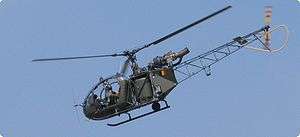
On 12 March 1955, the prototype SE 3130 performed its maiden flight;[2][3][4] within three months, on 6 June, a pre-production Alouette II, flown by Jean Boulet, established a new helicopter altitude record of 8,209 m (26,932 ft).[5][6][7] According to the manufacturer, such early demonstrations of the Alouette II had served to promote the performance and advantages of turbine helicopters over their piston-engined counterparts.[1]
In April 1956, the first production Alouette II was completed, making it the first production turbine-powered helicopter in the world.[1][4] Upon completion, several of the initial production models were dispatched for a series of evaluation flights in the Alps.[1] On 13 June 1958, a single SE 3130, again flown by Boulet, re-took the altitude record, reaching a height of 10,984 m (36,027 ft).[6][8][9] In 1975, production of the Alouette II ended after more than 1,300 had been built; in 1969, a new high-altitude variant, the Aérospatiale SA 315B Lama had been developed to replace it in this niche capacity.[1][10] A slightly larger and more powerful helicopter in the form of the Aérospatiale Alouette III has also entered production, which had negatively impacted upon the demand for the older II model.[11]
Design

The Aérospatiale Alouette II is a French light helicopter, incorporating many innovations of its time.[7] It was powered by a single Turbomeca Artouste II turboshaft engine capable of generating a maximum output of 400 hp. The speed of the main rotor is controlled by an automated fuel supply governor, eliminating the necessity of a twist-grip throttle and a conventional link between the throttle and the collective-pitch.[7] Instead, the Alouette II uses a simple control lever arrangement, which acts to directly regulate the collective-pitch and actuate the governor while immediately and automatically applying the correct level of power to conform with flight condition. Without a clutch, the transmission is considerably simplified in both design and maintenance aspects.[7]
Despite being a light helicopter, the Alouette II possesses a reasonable lift capacity and can carry underslung loads on an external sling; during one high-profile public demonstration, one helicopter was able to air-lift a compact Citroen truck weighing in excess of half a ton without visible difficulty. While flying at sea level, the Alouette II uses only 300 of the powerplant's available 400 hp; accordingly, performance can be maintained while operated at a high altitude and withinin tropical conditions where the additional power would come into play.[7] It was capable of flying at altitudes of up to 2,286 meters above sea level while possessing an average climb rate of 250 meters per second and a typical maximum range of 563 miles.[12] Various alternative landing gear configurations could be fitted, including skids, wheels, or pontoons.[10]
The Alouette II is capable of accommodating a seating arrangement for up to five personnel, including the pilot; access to the cabin was provided via a pair of side-hinged doors.[7] The compact cockpit was provided with a dome-shapred windscreen which provided for excellent levels of external visibility.[12] The Alouette II also made innovative use of armaments. It was the first helicopter worldwide to be equipped with anti-tank munitions in the form of the SS.11 MCLOS wire-guided anti-tank missile.[13][3] In addition to anti-tank missiles, the French Army chose to arm their Alouette IIs with machine guns, while the French Navy outfitted theirs with aerial torpedos to conduct anti-submarine warfare (ASW) duties.[4]
Under operational conditions, the Alouette II often proved to be a relatively maintenance-intensive rotorcraft.[14] It required a high level of regular lubrication, the main rotorhead alone featuring 20 grease nipples that had to be re-lubricated after every five flight hours, while the drive shaft for the tail rotor was similarly demanding. Due to its high susceptibility to dust ingestion, some operators would have to remove the Alouette's rectangular sand filters after every landing in order to clean them.[14]
Operational history
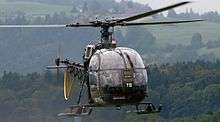
On 3 July 1956, prior to even entering civil service, the Alouette II was responsible for breaking new ground when it became the first helicopter to perform a mountain rescue mission, having been deployed to evacuate a mountaineer who had suffered from cardiac arrest at over 4,000 m (13,000 ft).[15] On 3 January 1957, the Alouette II was called upon again in order to rescue the crew of a crashed Sikorsky S-58, which had been searching for missing mountaineers Jean Vincendon and François Henry on Mont Blanc.[1]
On 2 May 1957, following a series of airborne trials, the Alouette II was awarded a French domestic certificate of airworthiness, which cleared the type to enter service with civil operators.[4] Initial production was allocated to fulfil those orders placed by the French military, as well as by civilian customers. During 1957, the first deliveries of the Alouette II were made to the French Army.[16] Shortly thereafter, large-scale orders for the type were received from serval foreign nations, including the United Kingdom, Federal Republic of Germany, and Austria.[10]
Almost immediately upon entering service, French forces commenced active combat operations using their fledgling Alouette II fleet; the type being placed into heavy use in the Algerian War, during which it made valuable contributions to France's activities in the theatre.[17] When used as a troop-transport, up to 4 fully equipped soldiers could be airlifted at a time. Additionally, a number of Alouette IIs were modified to become what has been argued by some to have been the world's first helicopter gunships; in this capacity, it would have been typically armed with Nord Aviation-built SS.10 or SS.11 anti-tank missiles.[17]

The nation of Rhodesia emerged as a prolific user of both the Alouette II and its enlarged sibling, the Alouette III.[17] Early operations were flown with an emphasis on its use by the Army and British South Africa Police, including paramilitary and aerial reconnaissance operations. Throughout the 1960s, the type progressively spread into additional roles, including aerial supply, casualty evacuation, communications relays, and troop-transports.[18] Rhodesian aerial operations would typically involve flying under relatively high and hot conditions, which reduced the efficiency of aircraft in general; however, the Alouette II proved to be both hardy and relatively resistant to battle damage.[12] In order to extend the inadequate range of the type, fuel caches were strategically deployed across the country to be used for refuelling purposes.[18]
In order to improve performance, Rhodesia's Alouette II fleet was subject to extensive modifications, including changes to their refueling apparatus, gun sights, cabin fittings, armouring, and armaments.[19] Over time, the Rhodesian Security Forces developed an innovative deployment tactic of rapidly encircling and enveloping enemies, known as the Fireforce, for which the Alouette II served as a core component.[17] The quick-reaction Fireforce battalions were centered at Centenary and Mount Darwin; however, an deliberate emphasis was placed on locating both rotorcraft and troops as close to a current or anticipated theatre of operations as would be feasibly possible.[20]
By 1975, at which point production of the type was terminated, in excess of 1,300 Alouette IIs had been constructed. The rotorcraft was also in use in over 80 countries, including 47 separate armed forces.[15] The Alouette II was produced and sold under licence by Brazil, Sweden, India and in the United States.[10] While succeeded in some respect by the SA 315B Lama, which was itself a derivative of the Alouette II; the French Army ultimately to replaced their Alouette II fleet with a newly developed observation and reconnaissance helicopter in the form of the Aérospatiale AS350 Écureuil.[21]
Variants
- SE 3130 Alouette II – After 1967 called SA 313B Alouette II.
- SE 3131 Gouverneur – Refined executive version with enclosed tailboom,[22] which was abandoned in favour of the Alouette III.[23]
- SE 3140 Alouette II – Proposed version, it was going to be powered by a 298 kW (400 hp) Turbomeca Turmo II engine. None were built.
- HKP 2 Alouette II – Swedish licence version of the SE 3130
- SA 318C Alouette II Astazou – It has a 550 shp (410 kW) Turbomeca Astazou IIA shaft turbine (derated to 360 shp) and strengthened transmission system of the Alouette III.
- SA 318C Alouette II (was SE 3180 Alouette II) – After 1967 it was called the SE 3150.
- SA 315B Lama – designed to meet an Indian armed forces requirement for operation in "hot and high" conditions; it combined the Artouste powerplant and rotor system of the Alouette III with a reinforced Alouette II airframe.
Operators

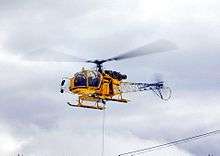
Former operators
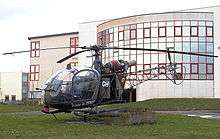
- French Air Force[35]
- French Army[36]
- French Navy [37]
- Gendarmerie Nationale [38]
- Securite Civile[39][40]
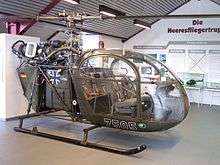

.jpg)
Specifications (Alouette II)
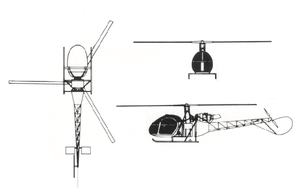

Data from Jane's All The World's Aircraft 1966–67[2]
General characteristics
- Crew: One
- Capacity: Four passengers
- Length: 9.66 m (31 ft 9 in)
- Rotor diameter: 10.20 m (33 ft 6 in)
- Height: 2.75 m (9 ft 0 in)
- Disc area: 81.7 m² (881.4 ft²)
- Empty weight: 895 kg (1,973 lb)
- Max. takeoff weight: 1,600 kg (3,527 lb)
- Powerplant: One × Turbomeca Artouste IIC6 turboshaft, 395 kW (530 hp) derated to 269 kW (460 hp) each
Performance
- Maximum speed: 185 km/h (100 knots, 115 mph) at sea level
- Cruise speed: 170 km/h (92 knots, 106 mph)
- Range: 565 km (305 nmi, 350 mi)
- Endurance: 4.1 hours
- Service ceiling: 2,300 m (7,545 ft)
- Rate of climb: 4.2 m/s (820 ft/min)
See also
| Wikimedia Commons has media related to Aérospatiale Alouette II. |
- Related development
- Related lists
References
Citations
- 1 2 3 4 5 6 "1955: SE3130 "Alouette II"." Eurocopter, Retrieved: 20 December 2015.
- 1 2 Taylor 1966, p. 61.
- 1 2 Boyne 2011, p. 74.
- 1 2 3 4 McGowen 2005, p. 74.
- ↑ "FAI Record ID #9876 - Altitude without payload. Class E-1 (Helicopters), turbine" Fédération Aéronautique Internationale (FAI). Retrieved: 21 September 2014.
- 1 2 "History of Rotorcraft World Records, Sub-class:E-1 (Helicopters), Category:General, Group 2:turbine" Archived 11 June 2007 at Archive.is. Fédération Aéronautique Internationale (FAI). Retrieved 3 November 2010.
- 1 2 3 4 5 6 Flight 8 July 1955, p. 54.
- ↑ "FAI Record ID #9874 - Altitude without payload. Class E-1 (Helicopters), turbine" Fédération Aéronautique Internationale (FAI). Retrieved: 21 September 2014.
- ↑ Taylor 1966, p. 2.
- 1 2 3 4 McGowen 2005, p. 75.
- ↑ McGowen 2005, p. 227.
- 1 2 3 Cocks 2015, p. 19.
- ↑ Helicopters at War - Blitz Editions, p. 63, ISBN 1-85605-345-8.
- 1 2 Cocks 2015, pp. 22-23.
- 1 2 Boyne 2011, p. 101.
- ↑ Cocks 2015, pp. 18-19.
- 1 2 3 4 Cocks 2015, p. 18.
- 1 2 Cocks 2015, p. 20.
- ↑ Cocks 2015, pp. 20-22.
- ↑ Cocks 2015, pp. 21-22.
- ↑ McGowen 2005, p. 124.
- ↑ "Business and Touring Aircraft: Sud-Aviation". Flight, 11 October 1957, p. 585.
- ↑ "Helicopters of the World:SE.3160 Alouette III". Flight, 15 May 1959, p. 684.
- 1 2 "World Air Forces 2013" (PDF). Flightglobal Insight. 2013. Retrieved 14 March 2013.
- ↑ "Ӧstereichische Luftstreitkräfte SE3130 Alouette II". Retrieved 12 March 2013.
- ↑ "Aviation légère de la force terrestre Alouette II". Retrieved 12 March 2013.
- ↑ "Gendarmerie Alouette II". Retrieved 12 March 2013.
- ↑ "World Air Forces 1981 pg. 328". Retrieved 14 March 2013.
- 1 2 3 "World Air Forces 1971 pg. 924-925". Retrieved 14 March 2013.
- ↑ "World Air Forces 1981 pg.329". flightglobal.com. Retrieved 14 March 2013.
- ↑ "World Air Forces 1981 pg.330". flightglobal.com. Retrieved 14 March 2013.
- ↑ "World Air Forces 1981 pg. 332". flightglobal.com. Retrieved 14 March 2013.
- ↑ "World Air Forces 1987 pg. 50". flightglobal.com. Retrieved 14 March 2013.
- ↑ "World Air Forces 1981 pg. 333". flightglobal.com. Retrieved 14 March 2013.
- ↑ "Armée de l'air Alouette II". Retrieved 12 March 2013.
- ↑ "Aviation légère de l'armée de Terre Alouette II". Retrieved 12 March 2013.
- ↑ "World Air Forces 1987 pg. 56". flightglobal.com. Retrieved 14 March 2013.
- ↑ "World Helicopter Market pg. 51". flightglobal.com. Retrieved 14 March 2013.
- ↑ "L’HISTORIQUE DE LA SECURITE CIVILE". helisecours.com. Retrieved 14 March 2013.
- ↑ "Securite Civil Sud-SA-318C". Demand Media. Retrieved 14 March 2013.
- ↑ "Heeresflieger Alouette II". Retrieved 12 March 2013.
- ↑ "Bundespolizei Alouette II". Retrieved 12 March 2013.
- ↑ "World Air Forces 1975 pg. 298". flightglobal.com. Retrieved 14 March 2013.
- ↑ "World Air Forces 1987 pg. 59". flightglobal.com. Retrieved 14 March 2013.
- 1 2 "World Air Forces 1981 pg. 347". flightglobal.com. Retrieved 14 March 2013.
- ↑ "World Air Forces 1975 pg. 302". flightglobal.com. Retrieved 14 March 2013.
- ↑ "World Air Forces 1981 pg. 351". flightglobal.com. Retrieved 14 March 2013.
- ↑ "Congo, Part 1; 1960-1963". ACIG. 2003. Retrieved 9 August 2013.
- ↑ "World Air Forces 1971 pg. 932". flightglobal.com. Retrieved 14 March 2013.
- ↑ "World Air Forces 1987 pg. 68". flightglobal.com. Retrieved 14 March 2013.
- ↑ "World Air Forces 1975 pg. 305". flightglobal.com. Retrieved 14 March 2013.
- ↑ "World Air Forces 1975 pg. 305". flightglobal.com. Retrieved 2 February 2014.
- ↑ "Koninklijke Luchtmacht SA 313". Retrieved 14 March 2013.
- 1 2 "Força Aérea Portuguesa Alouette II". Retrieved 12 March 2013.
- ↑ Nelson, Harold. Zimbabwe: A Country Study. pp. 237–317.
- ↑ "World Air Forces 1987 pg. 81". flightglobal.com. Retrieved 14 March 2013.
- ↑ "Suid-Afrikaanse Lugmag Alouette II". Retrieved 12 March 2013.
- ↑ "World Air Forces 1987 pg. 91". flightglobal.com. Retrieved 14 March 2013.
- ↑ "Schweizer luftwaffe Alouette II". Retrieved 12 March 2013.
- ↑ "Army Air Corps Alouette II". Retrieved 12 March 2013.
Bibliography
- Boyne, Walter. "How the Helicopter Changed Modern Warfare." Pelican Publishing Company, 2011. ISBN 1-58980-700-6.
- Cocks, Kerrin. "Rhodesian Fire Force 1966-80." Helion and Company, 2015. ISBN 1-91029-405-5.
- "Helicopters in Europe: Fourteen Different Types Seen at Paris". Flight, 8 July 1955, pp. 54–55.
- Taylor, John W. R. Jane's All The World's Aircraft 1966–67. London: Sampson Low, Marston & Company, 1966.
- McGowen, Stanley S. Helicopters: An Illustrated History of their Impact. Santa Barbara, California: ABC-CLIO, 2005. ISBN 1-85109-468-7.